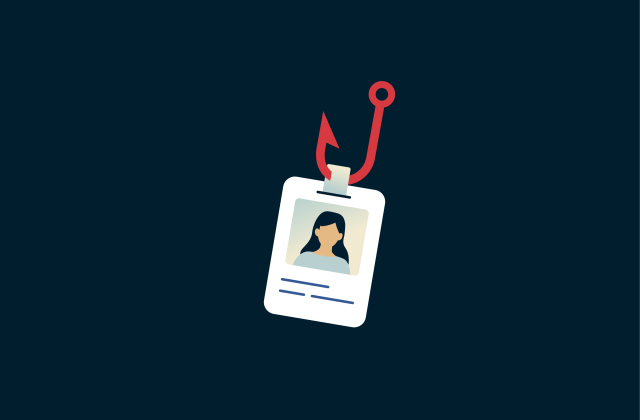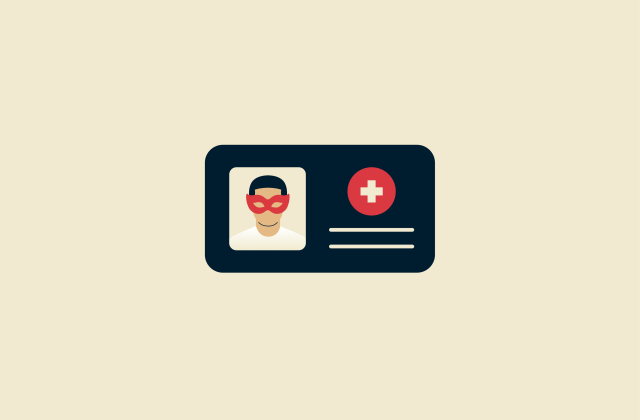Types of identity theft and how to protect yourself

Identity theft is on the rise, causing billions of dollars in losses every year and affecting victims’ credit and even legal standing.
Criminals employ a wide range of different techniques and adapt quickly as technology advances, making it challenging for individuals and organizations to stay ahead of new identity theft threats.
In this guide, we’ll lay out the most common and emerging forms of identity theft, how to spot them early, and the practical steps you can take to protect yourself.
Please note: This information is for general educational purposes and not financial or legal advice.
What is identity theft, and why does it matter?
Identity theft occurs when someone steals your personal information. An example of identity theft would be someone stealing your Social Security number or login credentials.
The goal of identity theft is often to commit identity fraud, where the criminal impersonates you using the stolen information to “prove” their identity and carry out deceptive or illegal acts. For example, they might make purchases, open new credit accounts, or access services in your name.
Note that the terms identity theft and identity fraud are sometimes used interchangeably because it’s often assumed that one will lead to the other, but they’re technically distinct ideas.

The consequences of identity theft can be severe and wide-ranging. You could face significant financial losses, and your credit score may also suffer significant damage, making it difficult or expensive to obtain loans, mortgages, or even rental housing in the future. In some cases, you might even face legal complications if criminals use your identity to commit crimes.
Additionally, the emotional toll can’t be overstated. Identity theft can make victims feel vulnerable and violated. What’s more, resolving identity theft often requires a lengthy and stressful process of disputing fraudulent charges, freezing accounts, and restoring personal records.
What are the main types of identity theft?
Here’s a quick overview of common identity theft methods. Understanding these can help you recognize potential threats and protect yourself more effectively.
Financial identity theft
Financial identity theft (or financial identity fraud) occurs when criminals use stolen personal information, like credit card numbers, bank account details, or Social Security numbers, to make unauthorized purchases, withdraw funds, or open new accounts in the victim’s name.
Medical identity theft
Medical identity theft or fraud occurs when criminals use a victim’s personal information to obtain medical services, prescription drugs, or file false insurance claims. This type of identity fraud can cause billing errors and corrupt medical records, potentially affecting the victim’s healthcare.
Criminal identity theft
Criminal identity theft happens when a criminal gives another person’s personal information to law enforcement or in a legal setting to mislead authorities about their true identity. This may allow the perpetrator to delay identification or receive a lighter sentence (if mistaken for someone with a cleaner record). For the victim, it may lead to wrongful arrests and tarnish their criminal record.
Child identity theft
Child identity theft is simply any kind of identity theft that targets minors. In most cases, though, it’s financial identity theft. Because children typically don’t apply for credit or check their reports, fraudulent accounts opened using their information often go undetected for years, which can make resolving the fraud more difficult.
Synthetic identity theft
Synthetic identity fraud occurs when criminals combine stolen personal information with fake information or information from another victim to create a new, fictitious identity. For example, they might use a valid Social Security number with a fake name and birthdate to open accounts or apply for credit.
This form of identity theft is difficult to detect because the identity doesn’t belong fully to any one person, making it challenging for victims and institutions to recognize the fraud.
Employment- and tax-related identity theft
Employment and tax identity theft occur when someone uses another person’s personal information to gain employment, earn income, or file fraudulent tax returns. Criminals may work under the victim’s identity to collect paychecks or claim refunds, leaving the victim with tax liabilities or discrepancies in their earnings records. This may create complications with the IRS and could affect future employment opportunities.
Biometric identity theft
Biometric identity theft involves stealing or replicating a person’s unique physical or behavioral traits, such as fingerprints, facial features, or voice patterns, to bypass security systems or impersonate them. For example, criminals might lift fingerprints from items the victim has touched or use high-resolution photos to trick facial recognition systems. Sometimes, they’ll even link their own biometric data with the victim’s personal information to commit fraud.
Because biometric traits can’t be changed like passwords, this type of theft is especially hard to address.
Social Security number (SSN) identity theft
Social Security identity theft (or Social Security fraud) occurs when a criminal gets their hands on someone else’s SSN. SSN identity theft facilitates a wide range of fraudulent activities because a person’s SSN is a key piece of personal information used for identification.
Online shopping and account takeover fraud
This type of identity theft or fraud occurs when a criminal gains unauthorized access to a victim’s online shopping or service accounts and makes unauthorized purchases, steals saved payment information, or changes account details.
Other forms of identity fraud
In addition to the common types covered above, identity fraud can take many other forms. These include utility fraud, government benefits fraud, rental or leasing fraud, and more.
While the specific targets and methods may differ, most types of identity fraud follow similar patterns: criminals use stolen personal information to impersonate victims and gain access to services or financial benefits illegally.

What is the most common form of identity theft?
Financial identity theft is one of the most common forms of identity theft because it offers immediate monetary gain for criminals, and it’s relatively easy to commit. Minimal technical knowledge is required to use stolen credit or debit card details, and large-scale data breaches supply criminals with an almost endless stream of personal and payment information.
Also, the volume of online transactions has increased dramatically in recent years, creating more opportunities. This is especially true when consumers don’t take basic precautions, such as verifying websites are secure, protecting their login credentials, and monitoring their financial statements.
Identity theft protection tools, such as ExpressVPN’s ID Alerts, can help protect against financial identity theft by scanning the dark web, where stolen data is often sold or shared, for your personal information. This gives you a chance to act before your information is misused.
What are the signs of identity theft?
Identity theft can manifest in various ways, depending on the type of fraud being committed. Common warning signs include:
- Unexplained attempts to open accounts or take out loans in your name.
- Receiving bills, collection notices, or account statements for transactions or services you didn’t authorize.
- Being locked out of your online banking, credit card, or other personal accounts.
- Discovering multiple tax returns or other official documents filed under your name without your knowledge.
How do I check to see if someone is using my identity?
One of the best ways to minimize damage is early detection, so it helps to regularly check if someone’s using your identity by:
- Reviewing credit reports for unfamiliar accounts or inquiries.
- Checking bank and credit card statements for transactions you don’t recognize.
- Verifying official documents like tax filings, medical statements, or government benefits records to make sure nothing has been fraudulently submitted.
What to do if you're a victim of identity theft
If your identity has been compromised, acting quickly can help you contain the damage. Here are some general steps you can take:
Report the fraud
First, contact the companies where the fraud occurred, such as your bank, credit card issuer, or any other place where you have accounts. Ask for their fraud department, explain the situation, and request that they close or freeze any compromised accounts.
Second, notify a credit bureau so they can place a fraud alert. This helps prevent criminals from opening new accounts in your name. In the U.S., you can contact Experian, Equifax, or TransUnion to request these services.
Third, report the identity theft to your national consumer protection agency or equivalent authority. For example, in the U.S., you can file a report with the Federal Trade Commission (FTC) on its website.
Finally, if you have identity theft insurance or coverage through an identity theft protection service, such as ExpressVPN’s ID Theft Insurance*, notify them promptly. This can help cover some of the costs involved in restoring your identity and recovering from fraud.
Freeze your credit
After reporting the fraud, you can consider placing a credit freeze with each of the major credit bureaus. A freeze prevents new creditors from accessing your credit file, which makes it much harder for criminals to open new accounts in your name. A credit freeze typically remains in place until you lift it, giving you long-term protection.
Monitor your accounts closely
Continue keeping a close watch on your bank statements, credit card activity, credit reports, and other online accounts for any suspicious transactions or unauthorized access.
Even if you’ve already addressed the initial fraud, identity theft can have a “long tail.” In other words, criminals may sell or reuse your personal information months or years later. This means accounts you believed were unaffected could still be targeted.
For more information on what to do if your identity is stolen, you can read our complete recovery guide.
How to protect against identity theft
While it’s important to recognize the common signs of identity theft, you should also be taking proactive steps to prevent it from happening in the first place.

Use a VPN and secure your internet connection
One of the many benefits of a virtual private network (VPN) is protection against identity theft. A VPN encrypts your internet traffic, which makes it unreadable to third parties. This means that cybercriminals will have a much harder time stealing sensitive information like passwords, financial data, or personal details, which can be used to commit identity fraud.
It’s especially important to use a VPN if you’re connecting to open public Wi-Fi networks, which are often unsecured and can be prime targets for cybercriminals.
Monitor your credit and set up alerts
Regularly monitoring your credit reports and account activity can help you catch identity theft early. Many banks, credit card companies, and credit bureaus also offer alerts for suspicious transactions or changes to your credit report.
For an added layer of protection, you can employ tools like ExpressVPN’s Credit Scanner, which makes it easy to track your credit score and activity and spot unauthorized use of your personal information.
Practice strong password hygiene and enable MFA
Using strong, unique passwords for all your online accounts is essential for protecting your personal information from identity theft. Avoid reusing passwords across multiple sites, and consider using a password manager, like ExpressVPN Keys, to generate and store complex passwords securely.
Enabling two-factor authentication (2FA) or multi-factor authentication (MFA) adds another layer of protection by requiring an additional verification step, such as a code sent to your phone, before anyone can access your accounts.
Use an identity theft protection service
Identity theft protection services are important for quickly detecting and responding to fraudulent activity. For example, ExpressVPN’s Identity Defender, which is available to ExpressVPN users in the U.S., helps protect your identity through four different means.
Its data removal services remove your personal information from data brokers and people search sites, reducing the amount of sensitive data about you available online. ID Alerts monitor for suspicious uses of your SSN and changes to your home address and notify you if your personal information is found on the dark web.
ID Theft Insurance provides coverage for certain costs involved in restoring your identity. Finally, Credit Scanner lets you monitor your credit score and report, track activity that could affect your score, and quickly access tools to protect your credit.
Help vulnerable family members stay protected
Certain groups are especially vulnerable to identity theft, including children, the elderly, and less tech-savvy people. They’re more likely to fall for criminal tactics like phishing attacks and less likely to notice the signs of identity theft.
You can help protect these family members by setting up credit monitoring in their name, securing their devices and online accounts, and teaching them how to recognize phishing emails or other scams. Taking proactive steps on their behalf can prevent long-term damage and financial loss.
FAQ: Common questions about types of identity theft
What types of identity theft are the most harmful?
Financial identity theft and medical identity theft tend to be among the most harmful types. Financial identity theft can drain bank accounts, max out credit cards, or damage credit scores, creating long-term financial consequences.
Medical identity theft can corrupt medical records, lead to improper billing, and even jeopardize treatment decisions. Other types, such as criminal or employment identity theft, can also have serious legal and professional repercussions, but the immediate and tangible impact on finances and health often makes these kinds of fraud the most damaging.
Can I recover money lost to identity theft?
It’s sometimes possible to recover money lost to identity theft, but success depends on the type of fraud and how quickly it’s detected.
Many banks, credit card companies, and payment processors have fraud protection policies and will reimburse unauthorized transactions if reported promptly. However, some losses, particularly those related to fake loans, long-term credit damage, or complex scams, may be harder to recover. Acting quickly and keeping thorough records of all communications and transactions improves your chances of recovering lost funds.
How long does it take to resolve identity theft cases?
It depends on the type and complexity of the fraud. Simple cases, like unauthorized charges on a credit card, can sometimes be corrected in a few weeks, while more complex situations, such as tax fraud, medical identity theft, or synthetic identity fraud, can take several months or even years to fully resolve.
Generally speaking, if you’re a victim of identity theft, you should prepare for a long-term battle. Acting promptly and keeping detailed records can help reduce delays, but the resolution process often requires patience.
*The insurance is underwritten and administered by American Bankers Insurance Company of Florida, an Assurant company, under group or blanket policies issued to Array US Inc, or its respective affiliates for the benefit of its Members. Please refer to the actual policies for terms, conditions, and exclusions of coverage. Coverage may not be available in all jurisdictions. Review the Summary of Benefits.
Take the first step to protect yourself online. Try ExpressVPN risk-free.
Get ExpressVPN


















